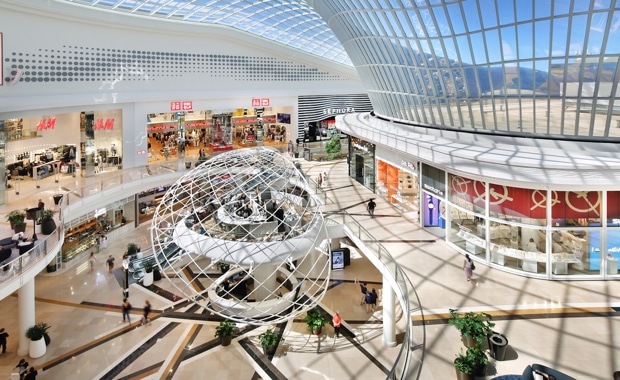
The “Amazon Effect” will soon be the buzzword on everyone’s lips Down Under, but is it really all doom and gloom for Australian retail?
Briefly the richest man in the world in July this year when the stock of his online retail empire soared, Jeff Bezos, self-made entrepreneur and Amazon CEO, has his sights set firmly on Australia… or does he? With the only mention of Australia in Amazon’s latest earnings release a reference to Cate Blanchett, perhaps Australia isn’t in Amazon’s crosshairs after all.
What do we really know about Amazon’s intentions Down Under?

The speed at which Amazon is growing has alarmed local retailers, and so it should, because the implications of a rapidly-growing retailer entering the Australian market are significant and have the potential to cause a massive shakeup in the Australian retail industry, the likes of which we — and indeed the entire world — have never been seen before.
While Amazon’s remarkable growth is a major concern, there’s also the matter of its market diversification, particularly its ongoing investment in logistics that’s customised delivery options and completely revolutionised the way consumers view shopping. If you find it difficult to believe that Amazon had somewhat humble beginnings as an online book retailer, you’re not alone.
Who will be hit the hardest?
Prior to rumours of Amazon’s arrival, bricks-and-mortar retailers were already feeling the pinch, especially department stores in shopping centres which are contractually obligated to stay open — even if they’re operating at a loss — due to the ‘must trade’ clauses in their long-term leases.
According to some financial experts, major department stores, especially Kmart due to its range and prices, will be hit hardest by Amazon entering the Australian market, but it’s safe to say that all retailers will be affected to some degree by the online retailer making its presence felt here.

[Image Credit: Power Retail]
Slowing revenue and reduced profits are commonplace among many major Australian retailers, with a few notable exceptions, especially JB Hifi which posted record profits this quarter and has emerged as a beacon of hope for retailers worried about Amazon’s arrival and the disruption it’s expected to cause. With Payless Shoes, children’s clothing retailer Gymboree and Dick Smith having closed over the past year, Australian retailers need a good news story, but is this it?
The success of JB Hifi this year is certainly a reason to have faith in the future of Australian retailers. But if major retailers like Kmart and Target, both of which have a massive presence in shopping centres across the country, feel the effects of Amazon’s arrival and this translates into less interest in maintaining a physical presence and pushes them further into online retailing, what does this mean for local shopping centres?
Do Australian shopping centres have a future?
It’s interesting to note that Australia has the most department stores per capita in the world — the US still has twice as much retail space per capita — and that 25% of these shopping centres are located in regional areas. The sheer number of shopping centres across the country is seen by some experts as representative of the failure of Australian retailers to embrace online sales, instead preferring to cling to the bricks-and-mortar model that has served most of them well.
While there’s a lot of talk about Amazon’s arrival and the impact it will have on shopping centres across the country, it doesn’t appear the owners of Australia’s most popular shopping centres are all that concerned. In fact, many seem quite confident that bricks-and-mortar retailing will continue to be strong due to their belief in the ongoing demand for real-world interactions.
As billionaire shopping centre owner, Bob Ell, recently stated, “The Amazon shopping style will grow but there is still a thrill taking the wife and family shopping. It’s entertainment, people still want that. People don’t want to be locked up in the house all day, they want to get out and see what’s going on in the world.” While the successful businessman is one of many who’s optimistic about the outlook for Australian shopping centres and retailers, some of his rivals, most notably Westfield’s Stephen Lowy, have warned of dire times ahead because Australia’s major retailers are “not investing sufficiently in technology” for the impact of Amazon arrival.
The difference in attitudes between the two highly successful businessmen show that opinions on the future of Australian retail and shopping centres are polarised. At one end of the spectrum lie Bob Ell and others who seem reluctant to embrace technology, while at the other end are Stephen Lowy and Vicinity Centres CEO, Angus McNaughton, who believe the future of Australian retail and shopping centres lies in embracing technological advances to meet the changing needs and expectations of consumers.
“I think we’ll see shopping centres becoming smarter, more sophisticated, not necessarily bigger,” says Mr McNaughton, who strongly believes that shopping centres will become “destinations”, places where people flock to for entertainment and a variety of other reasons, and not just shopping. His sentiments are echoed by Stockland CEO John Schroder, who says our local shopping centres will become town centres, community hubs where people go to eat, work out, seek medical treatment, pay bills, have their children minded and be entertained.

[Image Credit: The Urban Developer]
Could sophisticated, technologically-enhanced shopping be the way forward for Australian shopping centres? Chadstone Shopping Centre in Melbourne (the largest shopping centre in the Southern Hemisphere) has been quick to embrace the use of new technology, including facial recognition, to deliver personalised shopping experiences. According to Angus McNaughton, “We also expect to see technologies that can identify who you are, and what you like so that we can offer a personalised shopping experience when you come into our centre.”
Young consumers and the Amazon effect
According to several recent surveys, young consumers are more interested in cheaper products than older shoppers who tend to be more interested in the variety and range on offer. While both trends could indicate that Amazon’s arrival will be every bit as disruptive as many believe — Amazon is able to offer extremely low prices and a variety and range few retailers can compete with — that doesn’t indicate that the outlook for Australian retailers is all doom and gloom.
Millennials and Generation Zers, our tech-savvy generations, are not only spending less online than Generation Xers and Baby Boomers, but have repeatedly affirmed their preference for in-person shopping over online shopping. A recent AMP report debunks the myth that young people are overwhelmingly gravitating to online shopping, with 87% of Australian respondents saying they “like or love” shopping in person compared to 79% who said the same of shopping online.
This not only shows that the younger people haven’t been as quick to embrace online shopping as many believe, but also indicates that shopping centres and retail stores will still be in demand for many years to come. As AMP Capital’s managing director, Mark Kirkland, says, shopping centres are “delivering an offer that you can’t get online,” and that these young shoppers “want to be able touch and feel the product, they want to be able to talk to the sales assistants and get that extra piece of advice. And they want to treat it as a social transaction with their friends.”
Have a little faith in Australia’s younger generations
Certainly, there’s a lot to be optimistic about when we look at Australia’s young consumers, after all, they represent the future of shopping and consumerism in our fair land, but should we place all our hopes on the shoulders of Millennials and Generation Z? Fortunately, there are a number of additional reasons to be hopeful, as several recent surveys have shown. One of the most notable of these was commissioned by CouriersPlease, which separated the three main focuses of Amazon — price, selection and delivery — to gauge the preferences of Australian shoppers.
Understandably, price was the most common reason why respondents would shop on Amazon, but what was interesting is that price is more important for younger shoppers than their older counterparts. Selection was more important for older generations than younger generations, with 58% of 50-somethings responding that the vast selection would be the main reason they would shop on Amazon compared to 46% of people in their 20s.
Fast delivery, which the online retailer is well-known for, featured the least prominently among respondents, which is intriguing considering that its super-fast delivery service may not prove viable here in Australia due to the greater distances between cities, not to mention regional Australia with its vast open spaces.
That Amazon is likely to experience logistical difficulties is good news for local retailers, since it means they have more time to prepare themselves as Amazon works out how to effectively service the Australian market. And the reasons to be optimistic don’t end there, as in a recent investor call, Amazon outlined 20 strategic international markets and Australia wasn’t listed.
Learning from past mistakes
Despite the apocalyptic scenarios that are often depicted with the impending arrival of Amazon in Australia, there certainly seems a lot to be optimistic about, though could this be similar to a scenario that many Australians would be familiar with, namely the disruption that digital media had on Australian newspapers a decade ago? You may recall the perfect storm which struck the print industry here, with the majority of players so painfully slow to adapt to the changes that were clearly taking place around them.

[Image Credit: HBR]
A good example of this is SEEK, Australia’s most popular online employment classified that was dismissed by Fairfax and the other major media outlets who laughed at the disruption it was predicted it would cause. Fast forward to 2017 and where are the almighty Age and Sydney Morning Herald employment classifieds? In 2016, SEEK reported annual sales of $950 million and the two big names in employment classifieds are nowhere to be seen. Australian retailers would do well to learn from that experience and work at not making the same mistakes.
So, where to from here?
Starting by taking a lesson from the experience of the digital disruption among Australian newspapers and their failure to respond to the challenges facing them, local retailers need to focus on cost, range and convenience if they are to successfully compete with Amazon when it arrives. Fortunately, Amazon’s rather late entry into the Australian market provides local retailers of all sizes, from major retail chains through to specialist retailers, with an incredible amount of data (from its expansion into overseas markets) that can be leveraged to their advantage.
This data can be used to great effect here in Australia, as it enables local retailers to draw upon the experience of retailers, shopping centres and other players in Europe and other markets. Not all retailers were adversely affected by the arrival of Amazon into their respective markets, as many successfully upgraded the way they operate, deliver and take orders, often beating Amazon at its own game. As Graham Jackson, CEO of Fluent Retail, recently wrote in The Australian, “If you can optimise your store operations, delivery networks and order orchestration processes you can offer consumers a range of omnichannel fulfilment options and convenience that Amazon will struggle to compete with — certainly for the foreseeable future.”
This will take a concerted effort by Australian retailers, one which they’re more than capable of delivering due to the number of outstanding retailers in the industry, but it will require a group effort because retailers need to work harder to “prevent a consumer belief that Amazon is far better.” Our local retailers would be wise to take note of that statement, after all, with 27.5% of respondents in the CouriersPlease survey saying that “forced improvements to local retail” was what excited them most about the arrival of Amazon, it not only shows that consumers expect more than they’re currently receiving from retailers but that there’s also room for improvement.
Are you worried about the arrival of Amazon and what it could potentially mean for your business? We don’t claim to have all the answers, but a strong digital marketing strategy can position your business for success. Whether you’re based in Melbourne, Sydney or Brisbane, need assistance with SEO, PPC or Social Media, we’re here to help. Speak to us today — (07) 3216 1151 — or get in touch via our contact form.